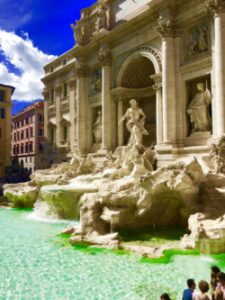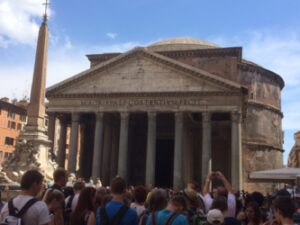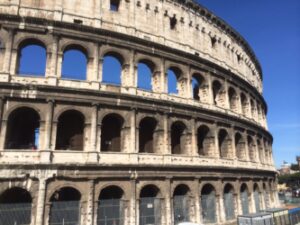In her purple-blue scarf, brilliant gold blouse and crimson skirt, Margaret had somehow vanished into the bulk of St Peter’s Basilica, somewhere in the swirling mass of worshippers and tourists. It seemed impossible since, in that outfit, I figured she’d be visible from outer space. At least she hadn’t worn her neon green jumpsuit, the same color prisoners wore in Italy. She would have been arrested on the spot, not for being a prisoner but for exhibiting such bad taste in Rome.

She had followed me through the Sistine Chapel into Saint Peter’s and joined the throng trying to photograph Michelangelo’s PIETA. Since the 15th century sculpture sits behind thick glass, recessed into a back lit side nook of the church, the photos would show a gray blob of clay in the distance, obscured by light glaring off the glass shield. No doubt Michelangelo is somewhere writhing in his grave at this venial sin. Friends viewing the photos later would ask questions like, ‘What’s the gray blob in the middle?’ , and ‘That blob is a Michelangelo? Wow, I thought he was much better than that.’ Margaret had probably taken her photo of the blob and gone off to look at something else. St Peter’s is easy to get lost in and, I figured, we’d find her soon enough.
In some respects, St Peter’s resembles Grand Central Station in New York. The place is so huge I imagine clouds form in the rafters. On some days it may rain in there. There were other similarities, too, like the smell of the summer crowd, the crying kids, the gum stuck to the floor and the lost tourists. But the place is a Baroque masterpiece, with all of the gold flourishes and deep red marble, cherubs dancing on every post and an altar the size of a football field.
Michelangelo’s Dome over the apse is perfection itself, beautifully proportioned with its clean classical lines, but the size of the church is staggering. It is the largest Christian church in the world, not by a little but by 20% over number two. The builders were very proud of this fact, indeed, and want you to know it.
Along the main path from the front door to the altar, there are markers set in the floor comparing the length of the building with that of other grand churches in the world. Marked in bronze set into the marble floor are indicators that say

‘The Washington DC Cathedral would stop here,’ and ‘The Milan Cathedral would stop here’. I expected to see ‘The Golden Gate Bridge would stop here,’ or ‘The Titanic would be only this long,’ but I didn’t. It was a way of bragging about size, as if size alone was the most important fact of the building. Size envy, and all that. But size is only one reason this place is rightly famous.
The real significance of the building is its history. According to legend, the far end of the church, somewhere under the altar, is the site where St Peter was crucified about 64 AD, or ‘CE’ if you prefer, to be perfectly culturally correct. The church sits on the site of a former race track built by the Roman Emperor Nero and was used as a place of persecution. Nero got his boxers in a bunch about a lot of things and one of them was Christians. Most everyone knows the tale about Nero fiddling while Rome burned but the Romans did, in fact, blame Nero for the fire and to deflect this, he blamed the Christians, not because of their religion necessarily but because he needed them for something else.
It wasn’t personal, mind you, he just wanted a scapegoat and the Christians were handy and identifiable, what with all the cross wearing and genuflecting. Loudly persecute a bunch of unwashed, outcast hermits the rest of the citizens are already wary of and get the public off your back for the bad fire and terrible recession that followed, this seemed to be his goal. In the end it didn’t work and Nero was assassinated but that’s another story. St Peter, although he wasn’t a saint at the time, was among Nero’s victims.
The Old St Peter’s was built out of wood about 330 CE so was already nearly 500 years old when Charlemagne was crowned Holy Roman Emperor here in 800. Made out of wood and it lasted 1200 years? Yes, but the word ‘lasted’ is a sliding scale. By the time New St Peters was built around, up and over the Old St Peter’s in about 1600, the original had become more sawdust and termite holes than structure. It swayed so badly in the wind the parishioners thought it was boogy-ing. When the new one was finished, the old one was dismantled and taken out the new front door. Seems to me, that’s quite an amazing bit of engineering especially for the era. Bernini’s colonnaded ‘arms’ that hug the immense St Peter’s Square out front, were added later. The whole project took a couple hundred years (we shouldn’t complain about road construction lasting 2 years) but it was worth the wait. The effect of the whole is inspiring and overwhelming. Including its gardens, Vatican City covers over 100 acres. St Peter’s alone is worth the ticket to Rome, but even sweeter is the Sistine Chapel.
No photos, no commentaries, no history can prepare you for the real thing. The Chapel is the size of a basketball court and the ceiling is curved and gabled which must’ve given Michelangelo fits. I imagine him standing on the floor in 1508 looking up wondering if Noah’s nose would appear 10 feet long or if Ekekiel’s hind end would look pornographic. The only relatively easy place to paint was in the middle so he plunked God creati
ng Adam at that point, with their famous fingers almost touching.
The chiropractors of Rome must be very busy, since half the millions of visitors have neck aches from looking up too long, trying to take in the vastness and beauty of the art work. The ceiling tells several Old Testament stories including scenes from the Book of Genesis all done in pictograph, like a graphic novel but better drawn, a gigantic Classics Illustrated. There’s Noah getting drunk, sleeping it off, and going to rehab. Not really, but the scene makes Noah an interesting realistic figure. There’s also Adam and Eve and the most famous, Creation of Life, right in the middle. Here and there are glimpses of other Old Testament figures from Isaiah and Jeremiah, to Ezekiel and Daniel. There’s so many famous people and characters up there you half expect to see the
 Kardashians or Queen Elizabeth II. Not really, but you get the point. This piece of art is awesome and worth every effort to see.
Kardashians or Queen Elizabeth II. Not really, but you get the point. This piece of art is awesome and worth every effort to see.
Michelangelo even had to create the scaffolding to reach the ceiling since he didn’t like standing on a ladder 6 stories tall. Imagine how much that would sway with a bucket of paint in your hand. He used a combo of paper sheets with holes outlining the characters, chalk, adhesive and paint to create this masterpiece in roughly 4 years. Some clergymen were outraged by the use of the Old Testament stories, which seemed too Jewish to them, and the naked people. Yes, there are naked people but you hardly notice that aspect because the art is so gorgeous, the stories so engaging.
 And yet, there’s more! As if the ceiling were not enough, along the side walls are works done by the likes of Botticelli and Leonardo da Vinci, as well as the altar painting, done again by Michelangelo, but 30 years after the ceiling. It’s as if the two works by him are from different artists, one full of the exuberance of youth and the Renaissance, and the other from a disappointed old man who has lost his youth and faith in people. But that’s another story.
And yet, there’s more! As if the ceiling were not enough, along the side walls are works done by the likes of Botticelli and Leonardo da Vinci, as well as the altar painting, done again by Michelangelo, but 30 years after the ceiling. It’s as if the two works by him are from different artists, one full of the exuberance of youth and the Renaissance, and the other from a disappointed old man who has lost his youth and faith in people. But that’s another story.
If all you did was fly the Atlantic to see the Sistine and St Peter’s, it would be money well spent. Then again that would be stupid because you’d miss the great food and wine, the Colosseum, the Ancient Roman Forum, the Area del Argentine where Julius Caesar was assassinated, the Capotoline Museums, the strolling wonder of via Cavour. Did I mention the great food and wine?
I was so lost in the beauty of the Sistine and the immensity of St Peter’s I had almost forgotten about Margaret. We made one more sweep of the interior but didn’t see the distinctive clothing so headed out. Ahead of us in the bright sunshine were the Swiss Guards dressed in Michelangelo’s only artistic error. Their costume is a cross
 between a medieval clown, a harlequin and a bad joke, all done up in purple-blue, brilliant gold and deep crimson topped with a Renaissance cap like an upside down coffee filter holder.
between a medieval clown, a harlequin and a bad joke, all done up in purple-blue, brilliant gold and deep crimson topped with a Renaissance cap like an upside down coffee filter holder.
And there was Margaret standing next to one of the young guards, the two of them like oddly matched twins in identical colors, Maurice Sendak parrots escaped from a story book. It was a toss up as to which one of them looked more ridiculous. They were chatting amiably, something the guards are not supposed to do but both clearly enjoying the conversation. I imagined Margaret saying,
‘Atrocious colors aren’t they!’ And laughing like hell. ‘Just abominable! I love to shock the hell out of folks!’
‘I do too ma’am, but this suit is torture to wear. You sweat from your armpits to your crotch and look like an aberrant bird from the Galapagos but we get the attention!’ And he laughed too.
‘I plan to stroll down via Veneto and shock the hell out of the Dior and Chanel crowd!’, says Margaret.
‘You do that ma’am, and take photos! I’d love to see those faces!’
I don’t know what they really s
aid but since I liked my scenario better, I just left it at that.
